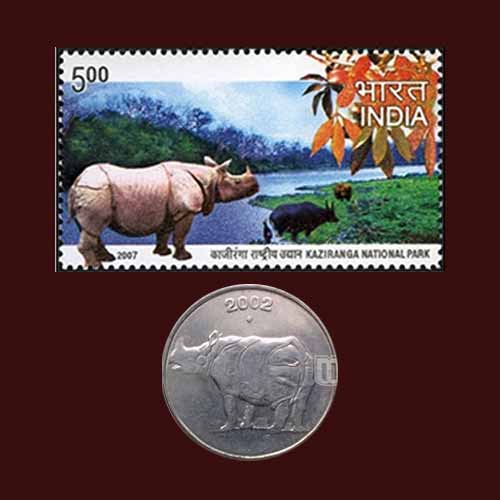Fascinating Archaeological Facts on Postage Stamps - 91
2025-08-23 Sat
Rhinoceros is one of the oldest land mammal species existing in India. There are five species of rhinoceros, categorized into two African species (the black rhinoceros and the White rhinoceros) and three Asian species (the Greater one-horned rhinoceros, the Sumatran rhinoceros, and the Javan rhinoceros). The Greater one-horned rhino (Rhinoceros unicornis) is commonly found in Nepal, Bhutan, Pakistan, and India. This species is the largest among the three Asian rhinoceros species.Rhinos have been roaming the earth for more than 60 million years. Historically, their distribution extended from the Shiwaliks in the NORTH to the Indus Valley in the WEST, Sumatra in Southeast Asia, and the Deccan region in South India. According to Dutta and Das in their work 'Rhinoceros unicornis in India since prehistoric Times (2020),' the history of rhinoceroses and their ancestors in India can be traced back to the Shiwaliks in northwestern India. They made their first appearance in the Eocene epoch in India. Evidence of their presence can be found in various locations including the Narmada Valley, Manjra Valley, Ghataprabha Valley, kurnool caves, and depictions of rhinoceros hunting in Bhimbetka. Their bones have also been discovered at Langhnaj along with numerous other Neolithic and Harappan sites.
Manuel, in 'Depiction of Rhinoceros: Transition from Popular Art to State Sponsored Art (2008),' notes that at Langhnaj during the Mesolithic period, rhino Bones were used as anvils, possibly for making microlithic tools. Throughout the Mesolithic and protohistoric periods, rhinoceroses were a common subject in rock art.
The Harappan civilization has produced substantial evidence of this animal. Bones of rhinoceroses have been reported from several sites, including Harappa, Kalibangan, Lothal, Kuntasi, Oriya Timbo, etc. Additionally, depictions of rhinoceroses can be found on terracotta figurines, steatite seals, terracotta masks, and copper tablets.
The tradition of depicting rhinoceroses continued in rock paintings and occasional terracotta works during the Chalcolithic period and into the Early Historic period. Notably, the Fifth Pillar Edict of Ashoka, from the 3rd century BCE, mentions the Indian rhinoceros as one of the animals designated for preservation. Subsequently, rhinoceroses were depicted on the Gupta Rhinoceros Slayer type coin of Kumaragupta.
The Indian rhinoceros is classified as vulnerable on the IUCN Red List, primarily due to its limited habitat range. Kaziranga National Park in #Assam and Pobitora Wildlife Sanctuary are two prominent sanctuaries dedicated to the conservation of Indian rhinoceroses. Besides, in 2005, the Indian Rhino Vision 2020 was launched to achieve a population of at least 3,000 Greater one-horned rhinoceroses across seven protected areas in Assam by the year 2020. According to the Press Information Bureau (#PIB), there were over 4,014 rhinoceroses in India in 2024.
India Post has issued a number of Stamps featuring rhinos since 1962. Furthermore, this majestic animal is depicted on the 25 paise coin and the Rs 10 banknote, reflecting its significance in Indian culture and Heritage.
Latest News
-
Antiochos I Soter Silver Tetradrachm, weighing 16.87 grams, sold for INR 22,000.
2025-10-07 TueAntiochos I, the Greek king of the Seleucid Empire, was of mixed heritage, being half-Iranian and ha...
-
Ghiyath Shah as Heir Apparent
2025-09-25 ThuGhiyath Shah was the ruler of the Malwa Sultanate, reigning from 1456 to 1500. From 1456 to 1469, he...
-
Malwa Sultan Mahmud Shah Silver Coins
2025-09-11 ThuMalwa Sultan Mahmud Shah minted silver coins in round and square flans. <br><br> For round coins,...
-
Malwa Sultan Mahmud Shah Billon coin
2025-08-26 TueMalwa Sultan Mahmud Shah's billon coins followed three weight standards: 100 rati, 96 rati, and 80 r...
-
Fascinating Archaeological Facts on Postage Stamps - 90
2025-08-23 SatUthiramerur, a Village in Kanchipuram, Tamil Nadu, is notable for its Temple inscriptions that descr...

